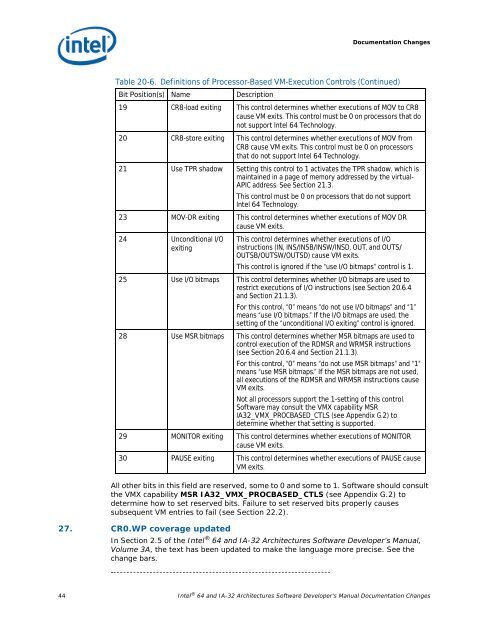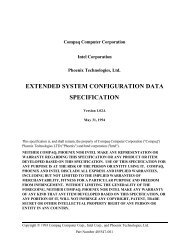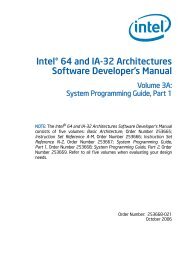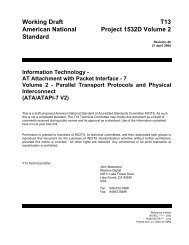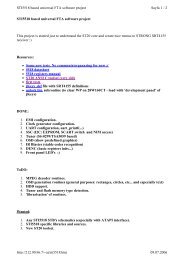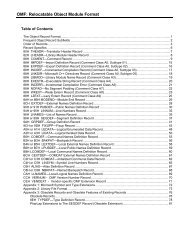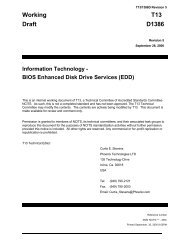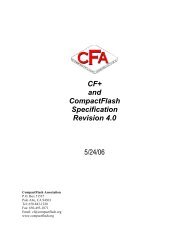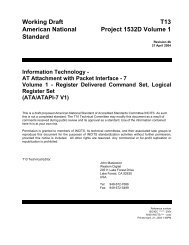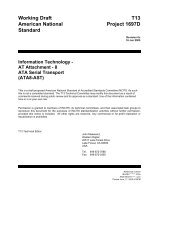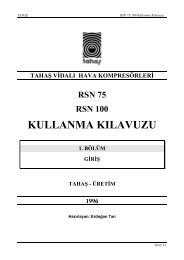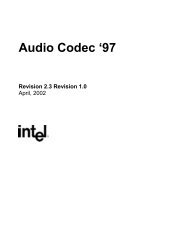Intel 64 and IA-32 Architectures Software Developer's Manual
Intel 64 and IA-32 Architectures Software Developer's Manual
Intel 64 and IA-32 Architectures Software Developer's Manual
Create successful ePaper yourself
Turn your PDF publications into a flip-book with our unique Google optimized e-Paper software.
Documentation Changes<br />
Table 20-6. Definitions of Processor-Based VM-Execution Controls (Continued)<br />
Bit Position(s) Name Description<br />
19 CR8-load exiting This control determines whether executions of MOV to CR8<br />
cause VM exits. This control must be 0 on processors that do<br />
not support <strong>Intel</strong> <strong>64</strong> Technology.<br />
20 CR8-store exiting This control determines whether executions of MOV from<br />
CR8 cause VM exits. This control must be 0 on processors<br />
that do not support <strong>Intel</strong> <strong>64</strong> Technology.<br />
21 Use TPR shadow Setting this control to 1 activates the TPR shadow, which is<br />
maintained in a page of memory addressed by the virtual-<br />
APIC address. See Section 21.3.<br />
This control must be 0 on processors that do not support<br />
<strong>Intel</strong> <strong>64</strong> Technology.<br />
23 MOV-DR exiting This control determines whether executions of MOV DR<br />
cause VM exits.<br />
24 Unconditional I/O<br />
exiting<br />
This control determines whether executions of I/O<br />
instructions (IN, INS/INSB/INSW/INSD, OUT, <strong>and</strong> OUTS/<br />
OUTSB/OUTSW/OUTSD) cause VM exits.<br />
This control is ignored if the “use I/O bitmaps” control is 1.<br />
25 Use I/O bitmaps This control determines whether I/O bitmaps are used to<br />
restrict executions of I/O instructions (see Section 20.6.4<br />
<strong>and</strong> Section 21.1.3).<br />
For this control, “0” means “do not use I/O bitmaps” <strong>and</strong> “1”<br />
means “use I/O bitmaps.” If the I/O bitmaps are used, the<br />
setting of the “unconditional I/O exiting” control is ignored.<br />
28 Use MSR bitmaps This control determines whether MSR bitmaps are used to<br />
control execution of the RDMSR <strong>and</strong> WRMSR instructions<br />
(see Section 20.6.4 <strong>and</strong> Section 21.1.3).<br />
For this control, “0” means “do not use MSR bitmaps” <strong>and</strong> “1”<br />
means “use MSR bitmaps.” If the MSR bitmaps are not used,<br />
all executions of the RDMSR <strong>and</strong> WRMSR instructions cause<br />
VM exits.<br />
Not all processors support the 1-setting of this control.<br />
<strong>Software</strong> may consult the VMX capability MSR<br />
<strong>IA</strong><strong>32</strong>_VMX_PROCBASED_CTLS (see Appendix G.2) to<br />
determine whether that setting is supported.<br />
29 MONITOR exiting This control determines whether executions of MONITOR<br />
cause VM exits.<br />
30 PAUSE exiting This control determines whether executions of PAUSE cause<br />
VM exits.<br />
All other bits in this field are reserved, some to 0 <strong>and</strong> some to 1. <strong>Software</strong> should consult<br />
the VMX capability MSR <strong>IA</strong><strong>32</strong>_VMX_PROCBASED_CTLS (see Appendix G.2) to<br />
determine how to set reserved bits. Failure to set reserved bits properly causes<br />
subsequent VM entries to fail (see Section 22.2).<br />
27. CR0.WP coverage updated<br />
In Section 2.5 of the <strong>Intel</strong> ® <strong>64</strong> <strong>and</strong> <strong>IA</strong>-<strong>32</strong> <strong>Architectures</strong> <strong>Software</strong> Developer’s <strong>Manual</strong>,<br />
Volume 3A, the text has been updated to make the language more precise. See the<br />
change bars.<br />
-------------------------------------------------------------------<br />
44 <strong>Intel</strong> ® <strong>64</strong> <strong>and</strong> <strong>IA</strong>-<strong>32</strong> <strong>Architectures</strong> <strong>Software</strong> Developer’s <strong>Manual</strong> Documentation Changes


